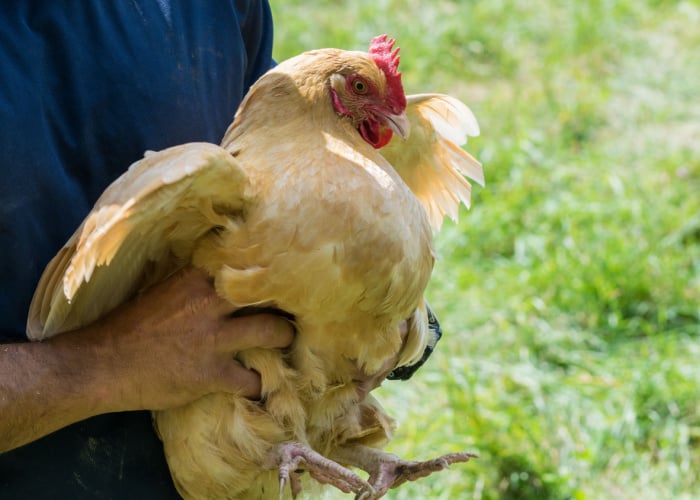Does your chicken struggleto pick up food and often injure other birds due to its overgrown beak?
If that’s the case, you need to trim its beak.
But how is chicken beak trimming performed, and is it really necessary for poultry birds?
In this article, we’ll discuss:
- 喙削减对幼禽至关重要的原因ry birds
- life-saving tips on how to trim chicken beak
- and the pros and cons of the controversial procedure of chicken beak trimming
But before that, let us first define beak trimming and its importance for poultry birds.
What is Chicken Beak Trimming?
Beak trimming in poultry is theprocess of removing about one-quarter to one-third of a chicken’s upper beakor both the upper and lower beak.
It’s worth noting that the upper half of chicken beaks is naturally a little longer than the lower half.
And chickens can actually handle their beaks and keep them groomed.
How do chickens keep their beaks trimmed?
Free-ranging chickens can wipe its beak on the ground to clean and keep them from growing by regularlyfiling their beaks against rocks and other rough surfaces.
That’s why some poultry owners provide rocks, paved stones, or decorative rocks for their birds.
But those in crowded cages, floor pens, and aviaries can’t file their beaks.
And if the chicken can’t keep the upper half worn down, it can overgrow and interfere with the chicken’s daily routines.
So why do chicken keepers need to trim their bird’s beaks?
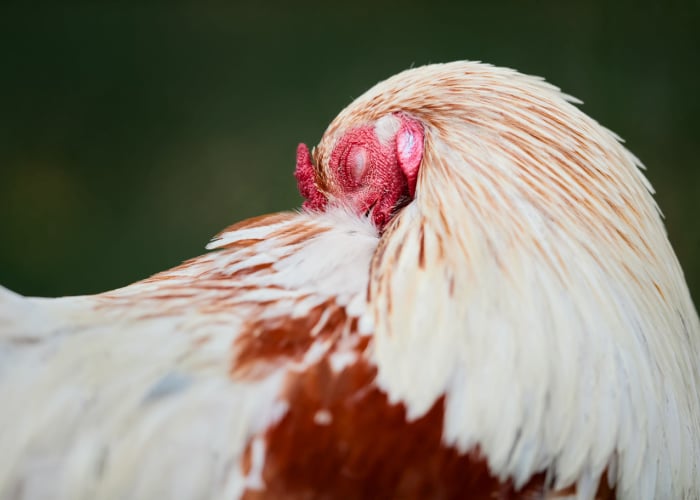
Why Are Chicken Beaks Trimmed?
This time, let’s discuss why you need to trim chicken beaks.
The main purpose of chicken beak trimming is toreduce peck injuries and death in a flock.
众所周知,鸡会啄t each other to show dominance.
However,feather peckingis also common among these poultry birds.
It happens when they’re stressed by poor management practices.
They then start picking their feathers, comb, and toes and vent out their stress to other birds.
In worse cases, chickens with open wounds or blood can be a victim ofcannibalism.
When a chicken starts attacking another flockmate by pecking, tearing, and consuming its skin, tissue, organs, or any part of its body, other birds may join and imitate the attacker.
This learned behavior can spread quickly in a flock because poultry birds such as chickens, ducks, turkeys, quails, and pheasants tend to imitate each other.
So, when one flock member starts attacking another chicken aggressively, others will follow, and it can result in huge losses due to flesh injuries and death.
Furthermore,overgrown beaks can interfere with a chicken’s day-to-day life,from preening to nesting and social interactions.
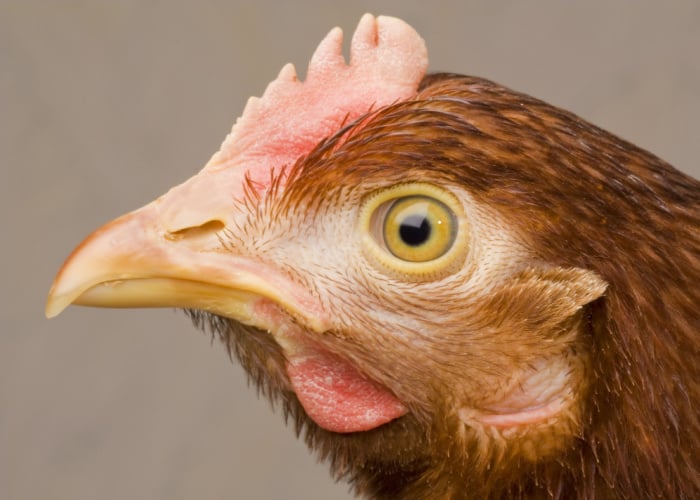
Four Common Chicken Beak Trimming Techniques
You can trim chicken beaks in many ways, including lasers, freeze-drying, and chemicals.
But here are four common categories of chicken beak trimming techniques you can use on your bird.
1. Mechanical
One of the most common techniques for trimming beaks isusing a blade or scissor-like devices such as secateurs or pruning shears.
But you can also use nail clippers for small dogs or cats or a human toenail for bantam chickens.
The advantage of using mechanical secateurs is they only cause minimal damage to the bird’s underlying tissue.
And you’d notice there’s little to no bleeding on the stump’s tissue within 24 hours after trimming.
Furthermore, according tostudies, beaks increased in size 21 days after the trim and had extensive bone regrowth that continued up to 42 days after the trim.
Birds may suffer acute pain after trimming or clipping chicken beaks, but they’re not likely to develop neuroma as long as they’re trimmed precisely.
2. Hot-blade
Another common chicken beak clipping or trimming technique is using a mechanized hot blade.
But based on astudy on turkeys, this causes tissue damage near the cut edge.
The amount of tissue destruction varied depending on the blade temperature and the amount of time it was in contact with the beak.
Although it’s slightly painful, there’s a low chance of developing neuroma formation among the turkeys and Pekin ducks.
3. Electric
You can also use electric current to damage and trim the tip of a chicken’s beak.
However, this method can cause the greatest amount of tissue damage.
In a study where turkeys’ beak was trimmed with the Bio-Baker, a device that produces high voltage electric current, on both sides of the beak, the poor turkeys suffered from large tissue damage.
In an in-depth examination 24 hours after using Bio-Beaker, it was observed the epidermis of the beaks’ upper surface was damaged.
Although there’s less damage on the lower surface, which was extensively healed and has regrown after 21 days, this isn’t ideal for you if you want less painful options.
In about 42 days after the trimming, the beaks will appear to be normal even though they’re shorter than the untrimmed ones.
But the advantage of this method is that birds trimmed with electric current aren’t likely to develop neuromas.
4. Infrared
Another efficient way of cutting chicken beaks off is using infrared light.
It isBritish Farm Animal Welfare Council’sgo-to method because it helps avoid creating an open wound and sequela.
Furthermore, birds are less likely to suffer from stress and pain with this method.
鸡只需要被掳获克制的坚定r head for a short period of time (about 15 seconds) and suspended during the treatment.
You don’t need to worry about infrared light’s effect on your bird’s productivity because astudythat compared this method with the hot-blade trimming technique reported that there’s no difference in laying hen’s egg production or body when these two methods were used.
Furthermore, there’s no difference between the two regarding stress based on the study, which means this method is safe even for laying hens.
In fact, those chickens who got trimmed using infrared light had excellent feather conditions and reduced aggressiveness when they were under high light intensity despite having longer beak stumps.
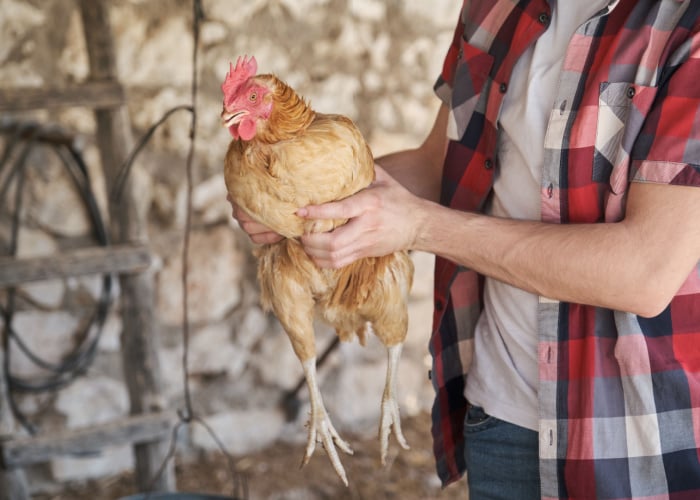
How to Trim Chicken Beak?
Beak cutting in chickens is an invasive procedure that can put your bird’s life at risk.
That’s why it’s best to live the job to professionals who are experts in trimming chicken beaks.
But there may be some circumstances where an avian vet isn’t available in your local area, and you must do it yourself.
It’s possible to carry this out, but the process may vary depending on the method used.
Since it’s easier to find secateurs or alternatives, we’ll focus on the mechanical technique in this guide.
Similar to hair, claws, and hooves, chicken beaks are made of keratin; that’s why you can use nail clippers for cats and dogs to trim them.
But you need to be very careful.
Otherwise, you’d cut their quick and cause profuse bleeding.
Pre-Trimming Tips
1. Two days before and after trimming or clipping chicken beaks,add 20 mg of vitamins K and C to 1 liter of waterto prepare her body and immunity for this process.
2.Wrap your chicken securely with a towelto restrain her while trimming her beak.
If your bird is too stressed or turns aggressive, you need to give her time to cool down and ask for a helping hand to hold the chicken for you.
3. It’d also help if you couldarrange all the tools mentioned below in an accessible areato get the job done easily and prepare cool water if you carry this out on a hot summer day.
So, How Should You Trim a Chicken’s Beak?
Materials For Chicken Beak Trimming
- Secateurs or nail clippers for small cats or dogs or human toenails for bantam chickens
- Nail file
- Towel
- Moist cloth or paper towel
- Cornstarch or styptic powder
- Sterile gauze
- Electrolytes
Here’s a step-by-step instruction to guide you throughout this process.
Trimming Process
1. Start by opening your chicken’s mouth tocheck the top beak’s colorationand see where to begin trimming.
2. If you noticed your chicken’s beak is just slightly overgrown, a nail file is enough to trim it down.
Just sand it down with the nail file by sweeping it in a direction away from the bird’s face.
Check for rough spots and sand them down in a gentle manner and file them evenly on both sides to avoid lopsidedness.
3. But if your bird’s beak is moderately overgrown, you’ll need to use clippers or secateurs to trim it.
In this case, you need to be careful not to snip the bird’s quick.
Otherwise, your feathery companion will suffer from bleeding and pain.
How will you know where to clip?
Well, here’s a hack you need to know. Observe the chicken’s mouth and see where the live tissue ends.
Oftentimes, the part of the beak that needs to be trimmed is a little lighter and more translucent than other parts of the beak.
4. To avoid cutting the quick and causing bleeding,clip just a tiny bit off at a time.
5. To ensure the beak is well-shaped and centered,alternate the sides while trimming, look for rough or sharp edges, and smooth them out with the nail file.
6. After trimming the beaks successfully, you need toget rid of the dust and minuscule beak fragmentsby wiping the beak’s top and sides with a moist cloth or paper towel.
7. But if you cut too far and notice bleeding, you need to dip your chicken’s beak intostyptic powderor cornstarch to stop it from bleeding.
Keep the powder on their beak, and don’t wipe it off until you know it has stopped bleeding.
8. After some time, check if the bleeding has ceased.
If it did, wipe the powder with a sterile gauze to remove the blood off the chicken’s beak.
But if you’ve unintentionally clipped your bird’s beak up to the living tissue and excessive bleeding occurs, you’ll need to contact your avian vet or local extension office to ask for assistance in caring for the bleeding bird and its needs.
Post-Trimming Tips
1.Prepare electrolytes to add to your chicken’s watererbecause your bird might get stressed after the trimming procedure.
Electrolytes can help fight against physical symptoms that stress might cause.
2. To prevent your birds from pecking the bottom of thechicken feeder,increase their feed depth to at least 2 inchesin the first four to seven days post-trimming.
3. Encourage your bird to eat more byadding feed twice dailyor using mechanical feeders more often. And after cutting the beak, feed a pre-starter, starter, or high-density stress feed for a week.
4. For a few days after beak trimming, reduce water pressure ormanually activate cup watering systemsbecause freshly trimmed chicks find it challenging to operate automated waterers immediately.
5. Make sure your bird willnot get stressed with their housing system,vaccination, or worming a week before or 2 weeks after the trimming procedure.
6. Then,check the bird’s healing progressif there’s a significant beak regrowth after trimming.
A second trim may be necessary at or prior to eight weeks of age.
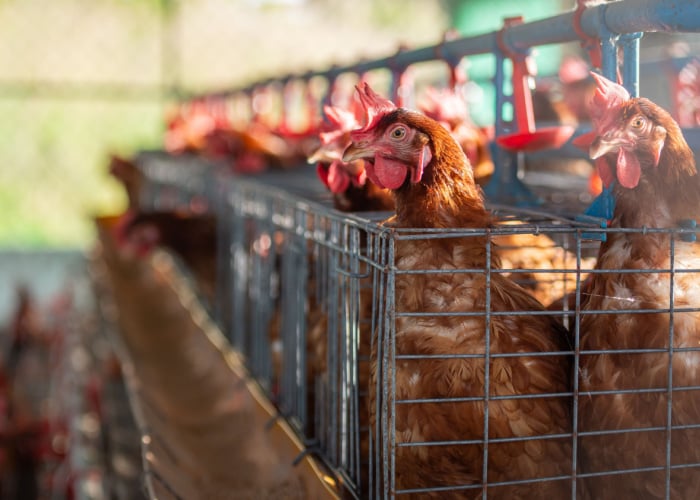
How Often Do Birds Need Their Beaks Trimmed?
The frequency of the trimming procedure may vary depending on the speed of the chicken’s beak recovery and regrowth of her beaks.
They can beretrimmed at 8 to 12 weeks old.
But regular beak corrections can be done every 8 to 12 months.
As for the lower part of the beak, you don’t need to trim it unless your bird is suffering from a scissor beak or has been severely debeaked.
Is It Humane to Trim Chicken Beaks?
Beak trimming is a subject of many debates since this procedure can cause stress and acute and chronic pain, and feeding difficulty among birds.
It can help preventfeather plucking, but this invasive procedure can affect the chicken’s sensory capabilities and usual behavior.
In some cases, it leads toneuromaformation.
Furthermore, there’s a chance of laying hens and broiler-breeding chickens might have uneven growth of the upper and lower mandibles, beak tip deformation, andabnormal beak occlusionas they age if they’re trimmed at a young age.
That’s why it’s prohibited in some countries.
However, it’s necessary in poultry management.
So even though it causes pain and several risks, it’s up to every poultry keeper whether to carry out chicken beak trimming or not.
If it’s for the sake of the flock’s safety and for a better quality of life for your chicken pets, then it’s worth all the risk.
Advantages and Disadvantages of Chicken Beak Trimming
FAQs About Chicken Beak Trimming
What is the age of beak trimming in poultry?
You can trim the beak when the bird is between 5 to 10 days old.
But for some poultry birds like quail, it’s recommended to perform this procedure when they’re 14 or 21 days of age.
What is the recommended length of beak trimming?
The recommended length is one-fourth to one-third of the upper beak. To get this length right, you must measure from the tip to the nostril.
Precision is crucial in this procedure to avoid neuroma or tumor formation.
Do chickens’ beaks need trimming?
Chickens with full and aligned beaks don’t need trimming, but those with crossed or overgrown upper beaks need this procedure.
Furthermore, poultry birds who have gone through debeaking in the past need to have regular beak trimming in their grooming needs.
How do you know when to trim a bird’s beak?
You’ll know if your bird needs trimming if its beak is abnormal or the upper or lower beak tip looks overgrown; your bird needs regular beak corrections every 1 to 12 months.
Do chicken beaks grow back?
Yes, their beaks do grow back after trimming, and they’ll continue growing throughout their lifetime.
It may take about three weeks or more to heal, and your chicken may struggle with adapting to its new beak while eating, but it’ll eventually grow.
What are the disadvantages of beak trimming?
The downsides of chicken beak trimming are short-term pain and stress after the procedure.
Furthermore, picking pelletedchicken feedcan be challenging for newly trimmed chickens, and they may develop tumors if the cut isn’t precise.
Is it okay to trim a bird’s beak?
It’s not advisable to trim your chicken’s beak at home without an avian vet’s guidance because if you mess up with the procedure and cut the quick, your feathery pet may suffer from profused bleeding and stress.
Is beak trimming beneficial or practical?
Yes, beak trimming is beneficial for poultry birds because it prevents feather picking and injuries and is practical for poultry keepers, but it comes with several risks.
Can you trim a chicken’s beak?
Yes, you can since secateurs or nail clippers are widely available, but if you’re a newbie in chicken-keeping, it’s best to leave the job to avian vets to avoid any mishap.
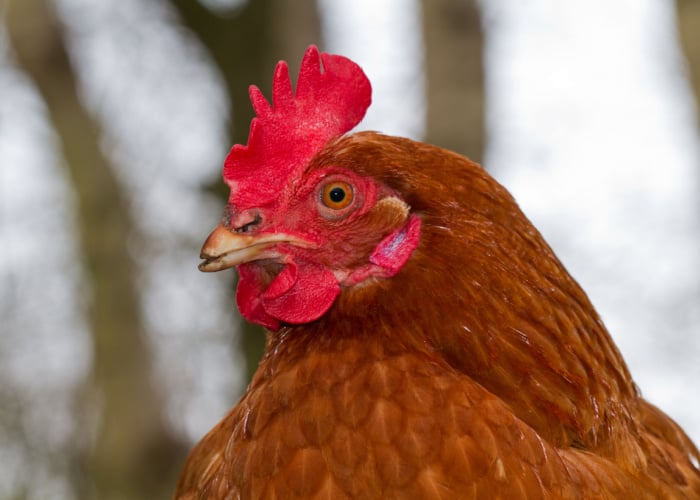
Final Thoughts About Chicken Beak Trimming
All chicken beak-trimming techniques induce pain, discomfort, and stress in birds.
But it depends on every poultry keeper whether to perform this procedure on the flock members with overgrown beaks.
If you think the pros outweigh the cons, it’s worth trying.
但最好是早期,最好在the bird’s first week of life, to reduce the chance of neuroma formation and avoid unusual oral behaviors.
However, the downside is that the beak-trimmed beaks are more susceptible to uneven beak or beak deformation.
So, what’s your final verdict? Will you get your beaks trimmed, or do it on your own?
If you’ve tried chicken beak trimming before, what are your hacks and tips on how to do it successfully?
Share with us your thought in the comment section below.

